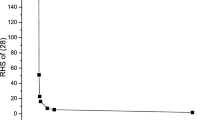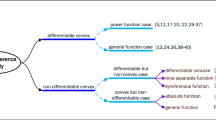Abstract
Fractional inequalities are useful in establishing the uniqueness of solution for partial differential equations of fractional order. Also they provide upper and lower bounds for solutions of fractional boundary value problems. In this paper we obtain some general integral inequalities containing generalized Mittag-Leffler function and some already known integral inequalities have been produced as special cases.
Similar content being viewed by others
1 Introduction
Inequalities play a vital role in both pure and applied mathematics. Specially, inequalities involving the derivative and the integral of functions are very captivating for researchers. Convex functions play an important role in the study of inequalities in all kinds of mathematical analysis.
Definition 1
A function \(f: I\rightarrow\mathbb{R}\), where I is an interval in \(\mathbb{R}\), is said to be a convex function if
holds for \(t\in[0,1]\) and \(x,y\in I\).
Theorem 1.1
Let a function \(f: I\rightarrow\mathbb{R}\) be convex on I. Then we have
where \(a,b\in I\), \(a< b\).
In the literature this inequality is known as the Hadamard inequality.
Recently, a number of researchers have taken great interest in establishing the Hadamard type inequalities for fractional integral operators of different kinds in the diverse field of fractional calculus. For example one may refer to [1–6].
2 Fractional derivative and integral operators
Fractional calculus is a theory of integral and differential operators of non-integral order. Many mathematicians, like Liouville, Riemann and Weyl, made major contributions to the theory of fractional calculus. The study on the fractional calculus continued with the contributions from Fourier, Abel, Lacroix, Leibniz, Grunwald and Letnikov. For details, see [2, 3, 7]. A first formulation of an integral operator of fractional order in reliable form is named the Riemann-Liouville fractional integral operator.
Definition 2
Let \(f\in L[a,b]\). Then Riemann-Liouville fractional integrals of f of order \(\nu>0\) with \(a\geq0\) are defined by
and
where
it is clear that \(\Gamma(\nu+1)=\nu\Gamma(\nu)\).
Definition 3
[9]
Let \(f\in L[a,b]\). Then Riemann-Liouville k-fractional integrals of f of order \(\nu>0\) with \(a\geq0\) are defined by
and
where
Also \(\Gamma(\nu)=\lim_{k\rightarrow1}\Gamma_{k}(\nu)\), \(\Gamma_{k}(\nu)=k^{\frac{\nu}{k}-1}\Gamma(\frac{\nu}{k})\) and \(\Gamma_{k}(\nu+k)=\nu\Gamma_{k}(\nu)\).
Actually, these forms of fractional integral operators have been formulated due to the work of Sonin [10], Letnikov [11] and then by Laurent [12]. Now a days a variety of fractional integral operators are under discussion. Many generalized fractional integral operators also take part in generalizing the theory of fractional integral operators [2, 3, 6, 8, 9, 13–15].
Definition 4
[15]
Let μ, ν, k, l, γ be positive real numbers and \(\omega\in\mathbb{R}\). Then the generalized fractional integral operator containing the generalized Mittag-Leffler function \(\epsilon_{\mu,\nu,l,\omega,a^{+}}^{\gamma,\delta,k}\) and \(\epsilon_{\mu,\nu,l,\omega,b^{-}}^{\gamma,\delta,k}\) for a real valued continuous function f is defined by
and
where the function \(E_{\mu,\nu,l}^{\gamma,\delta,k}\) is the generalized Mittag-Leffler function defined as
\((a)_{n}\) is the Pochhammer symbol, it is defined as \((a)_{n}= a(a+1)(a+2)\ldots(a+n-1), (a)_{0}=1\). If \(k=l=1\) in (1), then the integral operator \(\epsilon_{\mu,\nu,l,\omega,a^{+}}^{ \gamma,\delta,k}\) reduces to an integral operator \(\epsilon_{\mu,\nu,1,\omega,a^{+}}^{\gamma,\delta,1}\) containing generalized Mittag-Leffler function \(E_{\mu,\nu,1}^{\gamma,\delta,1}\) introduced by Srivastava and Tomovski in [6]. Along with \(k=l=1\), in addition if \(\delta=1\) then (1) reduces to an integral operator defined by Prabhaker in [4] containing Mittag-Leffler function \(E_{\mu,\nu}^{\gamma}\). For \(\omega=0\) in (1), the integral operator \(\epsilon_{\mu,\nu,l,\omega,a^{+}} ^{\gamma,\delta,k}\) reduces to the Riemann-Liouville fractional integral operator [15].
In [6, 15] the properties of the generalized integral operator and the generalized Mittag-Leffler function are studied in brief. In [15] it is proved that \(E_{\mu,\nu,l}^{\gamma, \delta,k}(t)\) is absolutely convergent for all \(t\in\mathbb{R}\) where \(k< l+\mu\).
Since
with \(\sum_{n=0}^{\infty}\vert\frac{(\gamma)_{kn} t^{n}}{\Gamma (\mu n+\nu) (\delta)_{ln}}\vert=S\), we have
We use this definition of S in the sequel in our results.
A lot of authors presently are working on inequalities involving fractional integral operators, for example the versions of Riemann-Liouville, Caputo, Hillfer, Canvati etc. In fact fractional integral inequalities are useful in establishing the uniqueness of solutions for partial differential equations of fractional order, also they provide upper and lower bounds for solutions of fractional boundary value problems.
In this paper we give some integral inequalities for a generalized fractional integral operator containing the generalized Mittag-Leffler function which are generalizations of several results proved in [16–19].
The following result was obtained by Sarikaya et al. in [19].
Theorem 2.1
Let \(f:[a,b]\rightarrow\mathbb{R}\) be a positive and convex function with \(0 \leq a< b\). If \(f \in L[a,b]\), then the following inequalities for a fractional integral hold:
3 Main results
First of all we establish the following result which would be helpful to obtain the main result.
Lemma 3.1
Let \(f:I\rightarrow\mathbb{R}\) be a differentiable mapping on I, \(a,b\in I\) with \(a< b\) and let \(g:[a,b]\rightarrow\mathbb{R}\) be continuous on \([a,b]\). If \(f'\in L[a,b]\), then the following equality holds:
Proof
To prove this lemma, we have
Similarly
Subtracting equation (5) from (4), we get (3). □
By using Lemma 3.1 we prove the following theorem.
Theorem 3.2
Let \(f:I\rightarrow\mathbb{R}\) be a differentiable function on I, \(a,b\in I\) with \(a< b\) and also let \(g:[a,b]\rightarrow\mathbb{R}\) be continuous function on \([a,b]\). If \(\vert f'\vert\) is convex function on \([a,b]\), then the following inequality holds for \(k< l+\mu\):
where \(\Vert g \Vert _{\infty}= \sup_{t\in[a,b]}\vert g(t)\vert\).
Proof
By Lemma 3.1, we have
By using \(\Vert g \Vert _{\infty}= \sup_{t\in[a,b]}\vert g(t)\vert\) and absolute convergence of the generalized Mittag-Leffler function, we have
Since \(\vert f'\vert\) is convex function, it can be written as
for \(t\in[a,b]\).
After simplification of inequality (9) we get the result. □
Remark 3.3
By giving particular values to parameters in the generalized Mittag-Leffler function several fractional integral inequalities can be obtained for corresponding fractional integrals. For example for the Riemann-Liouville fractional integral operator we have the following results.
Remark 3.4
In Theorem 3.2 for different values of the parameter, we have
-
(i)
if we put \(\omega=0\), then we get [18], Theorem 6;
-
(ii)
for \(\omega=0\), \(\nu=\frac{\mu}{k}\) and \(g(s)=1\), then we get [17], Corollary 2.3;
-
(iii)
for \(\omega=0\) and \(\nu=1\), we get [18], Corollary 3.
Next we give the following result.
Theorem 3.5
Let \(f:I\rightarrow\mathbb{R}\) be a differentiable function on I, \(a,b\in I\) with \(a< b\) and also let \(g:[a,b]\rightarrow\mathbb{R}\) be a continuous function on \([a,b]\). If \(\vert f'\vert^{q}\), where \(q>0\), is a convex function on \([a,b]\), then the following inequality holds for \(k< l+\mu\):
where \(\Vert g \Vert _{\infty}= \sup_{t\in[a,b]}\vert g(t)\vert\) and \(\frac{1}{p}+\frac{1}{q}=1\).
Proof
By using Lemma 3.1, we have
Using the Hölder inequality, we have
Using \(\Vert g \Vert _{\infty}= \sup_{t\in[a,b]}\vert g(t)\vert\) and absolute convergence of the generalized Mittag-Leffler function, we have
Since \(\vert f'(t)\vert^{q}\) is convex function, we have
After simplification, we get the required result. □
Remark 3.6
By giving particular values to the parameters in the generalized Mittag-Leffler function, several fractional integral inequalities can be obtained for corresponding fractional integrals. For example for the Riemann-Liouville fractional integral operator we have the following result.
Corollary 3.7
In Theorem 3.5, if we take \(\omega=0\) and \(g(s)=1\), then we have the following inequality for the Riemann-Liouville fractional integral operator:
Remark 3.8
For particular values of the parameters, Theorem 3.5 gives the following results.
-
(i)
If we put \(\omega=0\), then we get [18], Theorem 7.
-
(ii)
If we put \(\omega=0\), \(\nu=1\), then we get [18], Corollary 4.
-
(iii)
If we take \(\omega=0\) along with \(\nu=\frac{\mu}{k}\), then we get [17], Theorem 2.5.
The next result is the Hadamard type inequality for a generalized fractional integral operator.
Theorem 3.9
Let \(f:[a,b]\rightarrow\mathbb{R}\) be a positive and convex function with \(0 \leq a< b\). If \(f \in L[a,b]\), then the following inequalities for the generalized fractional integral hold:
where \(\omega'=\frac{2^{\mu}\omega}{(b-a)^{\mu}}\).
Proof
Since f is a convex function, we have
for \(x,y\in[a,b]\).
Substituting \(x=\frac{2-t}{2}a+\frac{t}{2}b\), \(y=\frac{t}{2}a+ \frac{2-t}{2}b\) for \(t\in[0,1]\), inequality (15) becomes
Multiplying both sides of (16) by \(t^{\nu-1}E_{\mu,\nu,l} ^{\gamma,\delta,k}(\omega t^{\mu})\) and integrating over \([0,1]\), we have
Setting \(u=\frac{2-t}{2}a+\frac{t}{2}b\) and \(v=\frac{t}{2}a+ \frac{2-t}{2}b\) in (17), we have
where \(\omega'=\frac{2^{\mu}\omega}{(b-a)^{\mu}}\).
This implies
On the other hand, convexity of f gives
Multiplying both sides of (19) by \(t^{\nu-1}E_{\mu,\nu,l} ^{\gamma,\delta,k}(\omega t^{\mu})\) and integrating over \([0,1]\), we have
Setting \(u=\frac{2-t}{2}a+\frac{t}{2}b\) and \(v=\frac{t}{2}a+ \frac{2-t}{2}b\) in (20), we have
This implies
Combining (18) and (22) we get the result. □
Corollary 3.10
In Theorem 3.9 if we take \(\omega=0\), then we get the following inequality for the Riemann-Liouville fractional integral operator:
Remark 3.11
On giving particular values to the parameters in Theorem 3.9, we have the following results.
-
(i)
If we put \(\omega=0\) and \(\nu=1\), we get the classical Hadamard inequality.
-
(ii)
If we put \(\omega=0\), then we get Theorem 2.1.
4 Conclusion
In Section 3, we give the generalizations of the Hermite-Hadamard type inequalities via generalized fractional integrals. Also we prove a version of the Hadamard inequality for convex functions via a generalized fractional integral operator. Being generalizations, the results of [16–19] have been obtained. The idea is extendable for m-convex, p-convex and other related classes of functions.
References
Farid, G: Hadamard and Fejér-Hadamard inequalities for generalized fractional integrals involving special functions. Konuralp J. Math. 4(1), 108-113 (2016)
Kilbas, AA, Srivastava, HM, Trujillo, JJ: Theory and Applications of Fractional Differential Equations. North-Holland Mathematics Studies, vol. 204. Elsevier, New York (2006)
Miller, K, Ross, B: An Introduction to the Fractional Differential Equations. Wiley-Interscience, New York (1993)
Prabhakar, TR: A singular integral equation with a generalized Mittag-Leffler function in the kernel. Yokohama Math. J. 19, 7-15 (1971)
Sarikaya, MZ, Set, E, Yaldiz, H, Basak, N: Hermite-Hadamard inequalities for fractional integrals and related fractional inequalities. Math. Comput. Model. 57, 2403-2407 (2013)
Srivastava, HM, Tomovski, Z: Fractional calculus with an integral operator containing generalized Mittag-Leffler function in the kernel. Appl. Math. Comput. (2009). doi:10.1016/j.amc.2009.01.055
Lazarević, M: Advanced Topics on Applications of Fractional Calculus on Control Problems, System Stability and Modeling. WSEAS Press, Republic of Serbia (2014)
Tomovski, Z, Hiller, R, Srivastava, HM: Fractional and operational calculus with generalized fractional derivative operators and Mittag-Leffler function. Integral Transforms Spec. Funct. 21(11), 797-814 (2011)
Mubeen, S, Habibullah, GM: k-fractional integrals and applications. Int. J. Contemp. Math. Sci. 7, 89-94 (2012)
Sonin, NY: On differentiation with arbitrary index. Moscow Matem. Sbornik. 6(1), 1-38 (1869)
Letnikov, AV: Theory of differentiation with an arbitrary index (Russian). Mat. Sb. 3, 1-66 (1868)
Laurent, H: Sur le calcul des derivees a indicies quelconques. Nouv. Ann. Math. 3(3), 240-252 (1884)
Abbas, G, Farid, G: Some integral inequalities for m-convex functions via generalized fractional integral operator containing generalized Mittag-Leffler function. Cogent Math. 3, 1269589 (2016)
Dalir, M, Bashour, M: Applications of fractional calculus. Appl. Math. Sci. 4(21), 1021-1032 (2010)
Salim, LTO, Faraj, AW: A generalization of Mittaf-Leffler function and integral operator associated with integral calculus. J. Fract. Calc. Appl. 3(5), 1-13 (2012)
Dragmoir, SS, Agarwal, RP: Two inequalities for differentiable mappings and applications to special means of real numbers and trapezoidal formula. Appl. Math. Lett. 11(5), 91-95 (1998)
Farid, G, Rehman, AU: Generalizations of some integral inequalities for fractional integral. Submitted
Sarikaya, MZ, Erden, S: On the Hermite-Hadamard Fejér type integral inequality for convex functions. Turk. J. Anal. Number Theory 2(3), 85-89 (2014)
Sarikaya, MZ, Yildirim, H: On Hermite-Hadamard type inequalities for Riemann-Liouville fractional integrals. Miskolc Math. Notes 17(2), 1049-1059 (2016)
Acknowledgements
The research of Ghulam Farid is supported by the Higher Education Commission of Pakistan. We are thankful to the editor and the reviewers on their guidance and constructive comments which helped us to improve the manuscript.
Author information
Authors and Affiliations
Corresponding author
Additional information
Competing interests
All the authors declare that they have no competing interests.
Authors’ contributions
All the authors worked equally on this paper and all read and approved the final manuscript.
Publisher’s Note
Springer Nature remains neutral with regard to jurisdictional claims in published maps and institutional affiliations.
Rights and permissions
Open Access This article is distributed under the terms of the Creative Commons Attribution 4.0 International License (http://creativecommons.org/licenses/by/4.0/), which permits unrestricted use, distribution, and reproduction in any medium, provided you give appropriate credit to the original author(s) and the source, provide a link to the Creative Commons license, and indicate if changes were made.
About this article
Cite this article
Abbas, G., Khan, K.A., Farid, G. et al. Generalizations of some fractional integral inequalities via generalized Mittag-Leffler function. J Inequal Appl 2017, 121 (2017). https://doi.org/10.1186/s13660-017-1389-9
Received:
Accepted:
Published:
DOI: https://doi.org/10.1186/s13660-017-1389-9




